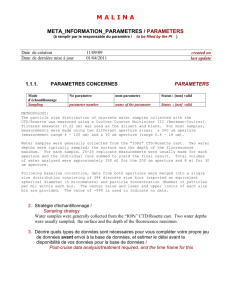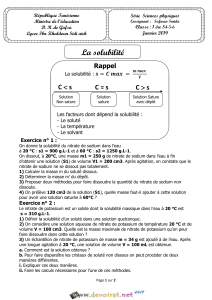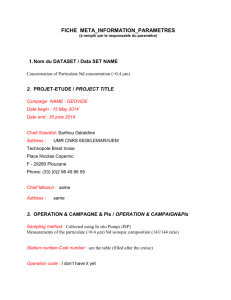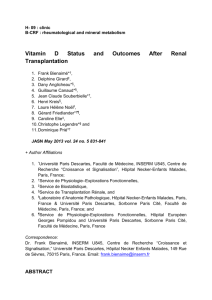Selection of staphylococci strains isolated from a Portuguese
advertisement
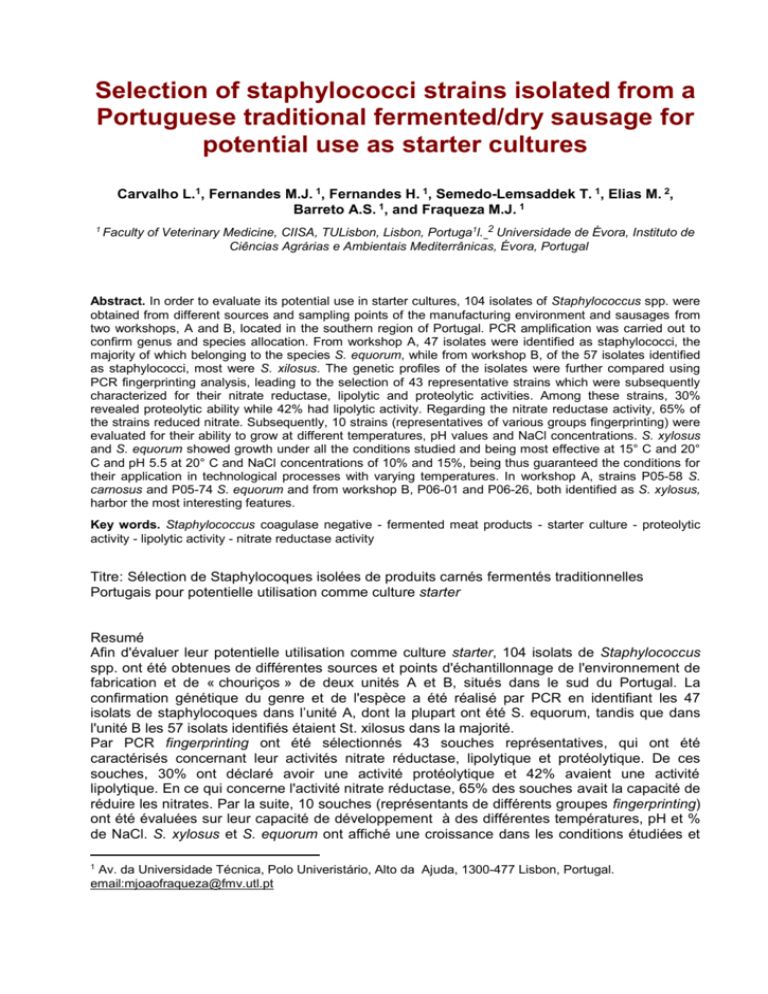
Selection of staphylococci strains isolated from a Portuguese traditional fermented/dry sausage for potential use as starter cultures Carvalho L.1, Fernandes M.J. 1, Fernandes H. 1, Semedo-Lemsaddek T. 1, Elias M. 2, Barreto A.S. 1, and Fraqueza M.J. 1 1 Faculty of Veterinary Medicine, CIISA, TULisbon, Lisbon, Portuga1l. 2 Universidade de Évora, Instituto de Ciências Agrárias e Ambientais Mediterrânicas, Évora, Portugal Abstract. In order to evaluate its potential use in starter cultures, 104 isolates of Staphylococcus spp. were obtained from different sources and sampling points of the manufacturing environment and sausages from two workshops, A and B, located in the southern region of Portugal. PCR amplification was carried out to confirm genus and species allocation. From workshop A, 47 isolates were identified as staphylococci, the majority of which belonging to the species S. equorum, while from workshop B, of the 57 isolates identified as staphylococci, most were S. xilosus. The genetic profiles of the isolates were further compared using PCR fingerprinting analysis, leading to the selection of 43 representative strains which were subsequently characterized for their nitrate reductase, lipolytic and proteolytic activities. Among these strains, 30% revealed proteolytic ability while 42% had lipolytic activity. Regarding the nitrate reductase activity, 65% of the strains reduced nitrate. Subsequently, 10 strains (representatives of various groups fingerprinting) were evaluated for their ability to grow at different temperatures, pH values and NaCl concentrations. S. xylosus and S. equorum showed growth under all the conditions studied and being most effective at 15° C and 20° C and pH 5.5 at 20° C and NaCl concentrations of 10% and 15%, being thus guaranteed the conditions for their application in technological processes with varying temperatures. In workshop A, strains P05-58 S. carnosus and P05-74 S. equorum and from workshop B, P06-01 and P06-26, both identified as S. xylosus, harbor the most interesting features. Key words. Staphylococcus coagulase negative - fermented meat products - starter culture - proteolytic activity - lipolytic activity - nitrate reductase activity Titre: Sélection de Staphylocoques isolées de produits carnés fermentés traditionnelles Portugais pour potentielle utilisation comme culture starter Resumé Afin d'évaluer leur potentielle utilisation comme culture starter, 104 isolats de Staphylococcus spp. ont été obtenues de différentes sources et points d'échantillonnage de l'environnement de fabrication et de « chouriços » de deux unités A et B, situés dans le sud du Portugal. La confirmation génétique du genre et de l'espèce a été réalisé par PCR en identifiant les 47 isolats de staphylocoques dans l’unité A, dont la plupart ont été S. equorum, tandis que dans l'unité B les 57 isolats identifiés étaient St. xilosus dans la majorité. Par PCR fingerprinting ont été sélectionnés 43 souches représentatives, qui ont été caractérisés concernant leur activités nitrate réductase, lipolytique et protéolytique. De ces souches, 30% ont déclaré avoir une activité protéolytique et 42% avaient une activité lipolytique. En ce qui concerne l'activité nitrate réductase, 65% des souches avait la capacité de réduire les nitrates. Par la suite, 10 souches (représentants de différents groupes fingerprinting) ont été évaluées sur leur capacité de développement à des différentes températures, pH et % de NaCl. S. xylosus et S. equorum ont affiché une croissance dans les conditions étudiées et 1 Av. da Universidade Técnica, Polo Univeristário, Alto da Ajuda, 1300-477 Lisbon, Portugal. email:mjoaofraqueza@fmv.utl.pt pourtant la plus efficace à 15 °C et 20 °C, soit dans un pH de 5.5 à 20 °C, soit dans des conditions de NaCl de 10% et 15% ; étant ainsi garanti les conditions de son application dans les procédés technologiques avec températures variables. La souche P05-58 S. carnosus et la P05-74 S. equorum provenant de l'unité A, ainsi que les S. xylosus P06-01 et P06-26, de l’unité B, ont démontré par ses caractéristiques être les plus intéressantes. Mots clé. Staphyloccocus coagulase négative, produits carnés fermentés, culture starter, l'activité protéolytique, l'activité lipolytique, l'activité de la nitrate réductase I – Introduction In Portugal there is a wide variety of traditional fermented/dry meat products, produced in small scale units being characterized by having in their manufacture a spontaneous fermentation by means of the so-called "house flora". Such products suffer a slight acidification and sensory characteristics are highly appreciated by consumers. Chorizo is a sausage made with pork, slightly fermented, smoked and dried, with a low pH and a decreased water activity, its production is characterized by a close relationship with the fermentative flora naturally present in the industrial environment. This type of flora is introduced in the meat during slaughter and increased in its concentration during manufacture of the fermented product. Each processing unit has a specific environmental flora, composed of useful microorganisms for the fermentation and the development of sensory characteristics in traditional sausages. The role of Staphylococcus as technological culture is well defined and the selection of the most interesting strains is a challenge to improve the hygienic and sensory characteristics of traditional sausages. This study aimed to characterize the technological flora of Staphylococcus spp. isolated from dry fermented sausages and the traditional manufacture environments, in order to assess their potential use as starter cultures. II – Material and Methods 1. Origin of Staphylococcus isolates The experimental work was carried out using 104 staphylococci isolated from the manufacturing environment, samples of traditional fermented and smoked sausage (chorizo) and secondary ingredients (garlic, pimento paste or bell pepper paste and natural casing) at two traditional meat industries (Plants A and B) located in Alentejo. The isolates were previously identified by biochemical miniaturized tests APIStaph (Biomerieux, France) by Fraqueza et al.(2006). At each manufacturing plant, samples were taken from the work surfaces (table, knife, grinder, mixer or stuffing machines) and from the fermented/smoked sausages in three different stages of manufacture (product after filling, product with half time smoking period and the final product) and secondary ingredients. 2. Extraction of DNA The isolates were grown in tryptose salt agar to obtain fresh culture by 24 h incubation at 37° C, and the extraction of genomic DNA was performed using the QIAamp DNA Mini Kit 02/2003" from Quiagen (Germany). 3. Identification The isolates were identified as belonging to the species Staphylococcus aureus, Staphylococcus epidermidis, Staphylococcus xylosus and Staphylococcus saprophyticus using a multiplex PCR method described by Morote-Bizot et al., (2004). Staphylococcus carnosus and Staphylococcus simulans were identified by PCR performed according to the methodology described by Blaiotta et al., (2004) while the identification of Staphylococcus equorum was based on the protocol described by Blaiotta, et al., (2004). 4. Genetic characterization and strain selection The selection of isolates to assess for technological interest was based on their genetic profiles using the PCR fingerprinting methodology according to Tenreiro (2007). Representative strains were selected by comparison of the fingerprinting profiles obtained. 5. Phenotypic characterization of technological functions The nitrate reductase activity was determined as described by Miralles et al (1996), while proteolytic activity was performed by sowing among PCA with gelatin, peptone and milk powder with subsequent flooding of the plate with a solution of mercuric chloride after incubation. To evaluate the lipolytic activity we used the Spirit Blue Agar medium (France). Selected representatives (n = 10) groups with different genetic profiles were characterized for their ability to grow in different conditions of temperature, pH values and sodium chloride concentrations in order to evaluate their potential use as starter cultures. We investigated 3 incubation temperatures (10° C, 15º C and 20° C), two pH values (5.0 and 5.5), the temperatures of 15 and 20º C and two different concentrations of sodium chloride (10 and 15%). 6. Statistical analysis Descriptive analysis of the results and their graphical presentation was obtained using Microsoft Office Excel 2007. The fingerprinting profiles obtained for each isolate were introduced in the Bionumerics software (version 4.61 [Applied Maths, Kortrijk, Belgium]) and dendrograms were constructed using the Pearson correlation coefficient and clustering method based on the unweighted average distance (UPGMA - unweighted pair group method with arithmetic average). III – Results and conclusions In Plant A, forty-seven Staphylococcus isolates were identified as members of the species S. equorum while in Plant B, fifty-seven isolates belong to the species S. xylosus. The genetic profiles of the isolates were compared by PCR fingerprinting (Fig. 1 and 2) and led to the selection of 43 staphylococci which were subsequently characterized for their nitrate reductase, lipolytic and proteolytic activities. Fig 1 PCR fingerprinting profiles of Staphylococcus strains Fig 2 Dendrogram analysis of the genetic profile of strains of Staphylococcus equorum By analyzing Figure 2 we can see that the genetic profiles clustered the isolates in three main groups, with similarities below 45%. Strains P05-04 and P05-07 harbor profiles with a genetic similarity above 90%, being considered identical or highly related. It was found that 30% of the strains showed proteolytic activity, while 42% showed lipolytic activity. As for the nitrate reductase activity, it was observed that about 65% of the strains reduced nitrate. Strains of S. xylosus and S. equorum (n = 10) grew in all the conditions studied, but their development was more effective at 15° C and 20° C, pH 5.5 at 20° C and 10% and 15% concentration of chloride sodium, thus suggesting features that can guaranteed their application in technological processes with varying temperatures (Table 1) Table 1 . Evaluation of proteolytic, lipolytic and nitrate reductase activity in strains of Staphylococcus xylosus and Staphylococcus equorum S. xylosus (n=10) S. equorum (n=8) Positivo Positivo Negativo Proteolytic Act. (n=18) Lipolytic Act (n=18) Nitrate reductase Act. (n=18) 30ºC/7 h (n=18) 3 10 7 - 5 20ºC/24 h (n=18) 15ºC/72h (n=18) 6 2 Negativo 3 1 5 7 5 - 8 4 8 7 7 1 1 IV – Conclusions Strains of S. carnosus P05-58 and S equorum P05-74 from Plant A and strains of S. xylosus P06-01 and P06-26 from Plant B, demonstrated by their characteristics to be the most interesting from the technological point of view. These results suggest their potential usage as starter cultures. Acknowledgements This work was financially supported by EU programe QLK1-CT2002-0240 and CIISA. Bibliography Blaiotta G., Ercolini D., Mauriello G., Salzano G. and Villani F., 2004. Raid and reliable identification of Staphylococcus equorum by a Species-Specific PCR Assay targeting the soda gene, In: Systematic and Applied Microbiology, 27: 696-702 Fraqueza M.J., Elias M., Talon R., Aymerich M.T., Ferreira M.C. and Barreto A.S., 2006. Microbiota of traditional dry sausage workshops from south of Portugal. In: Actas del Congreso Internacional de Ciencia y Tecnología de los Alimentos, Cordoba, Argentina. pp. 197. Miralles M.C., Flores J. and Perez-Martimez G., 1996. Biochemical tests for the selection of Staphylococcus strains as potencial meat starter cultures. In: Food Microbiology, 13: 1-10 Morot Bizot C., Talon R. and Leroy S., 2004. Development of a multiplex PCR for the identification of Saphylococcus genus and four staphylococcal species isolated from food, In: Journal of Applied Microbiology, 97: 1087-1094 Tenreiro R., 2007. ‘Curso Teórico e Prático de Diagnóstico e Diferenciação Molecular em MicrobiologiaMicrobiologia on the road’; Organização: Rogério Tenreiro. Co-organização: Manuela Pintado ‘Escola Superior de Biotecnologia da Universidade Católica Portuguesa’; Local: Escola Superior de Biotecnologia da Universidade Católica Portuguesa-Porto.
